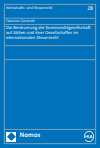Die Besteuerung der Kommanditgesellschaft auf Aktien und ihrer Gesellschafter im internationalen Steuerrecht
Zusammenfassung
Als hybride Gesellschaftsform zwischen Kapital- und Personengesellschaft bewegt sich die Kommanditgesellschaft auf Aktien (KGaA) zwischen intransparenter und transparenter Besteuerung. Im innerstaatlichen Dualismus der Unternehmensbesteuerung kommt ihr eine Sonderstellung zu. Das wirkt sich auch im internationalen Steuerrecht aus. Die Arbeit untersucht die steuerrechtliche Behandlung grenzüberschreitender Tätigkeiten einer KGaA und ihrer Gesellschafter anhand von In- und Outbound-Konstellationen und analysiert die Anwendung uni- sowie bilateraler Regelungen zur Vermeidung von Doppelbesteuerung. Das herausgearbeitete Zurechnungsmodell stellt nach Ansicht der Autorin eine systemkonforme Lösung für die KGaA im internationalen Steuerrecht dar.
Abstract
As a hybrid company form between a corporation and a partnership, the partnership limited by shares moves between non-transparent and transparent taxation. It has a special position in the domestic dualism of corporate taxation. This impacts the international tax law as well. The study examines the effects of cross-border activities of a partnership limited by shares and its shareholders under international tax law on the basis of inbound and outbound constellations and analyses the application of uni- and bilateral regulations for avoidance of double taxation. The result is an “attribution model” which, in the author’s opinion, represents a system-compliant solution for the partnership limited by shares in a cross-border context.
Schlagworte
Gesellschaftsrecht Kapitalgesellschaftsrecht KGaA Personengesellschaftsrecht Transparenzprinzip Trennungsprinzip Doppelbesteuerungsabkommen persönlich haftende Gesellschafter Kommanditaktionäre- Kapitel Ausklappen | EinklappenSeiten
- 27–32 Einleitung 27–32
- 377–398 Literaturverzeichnis 377–398

